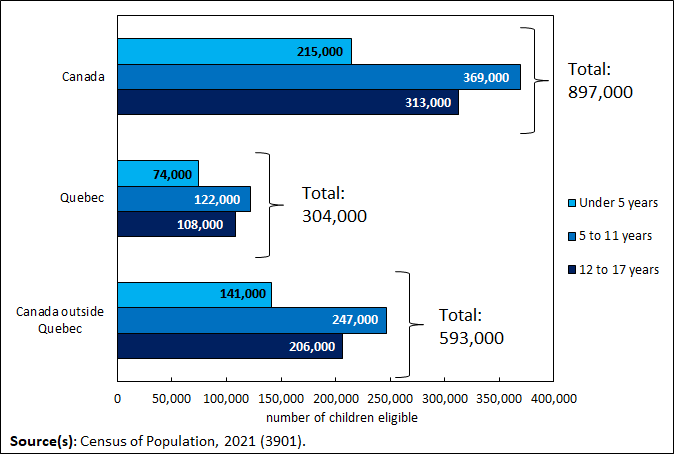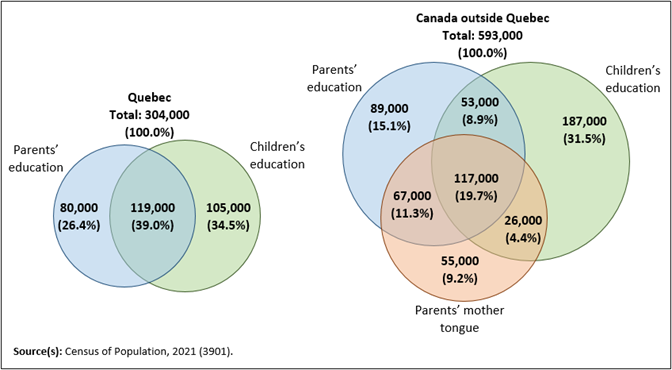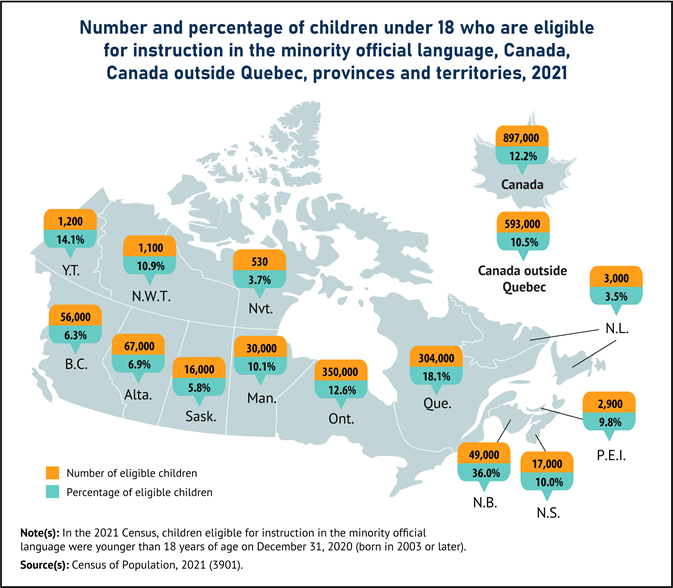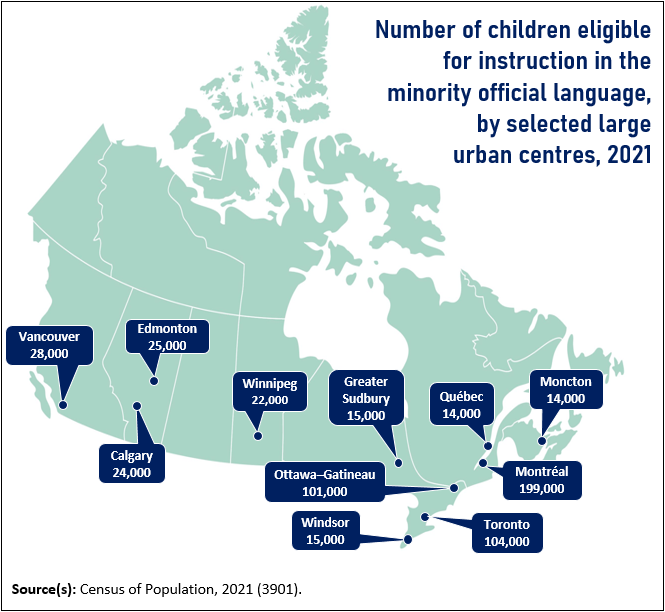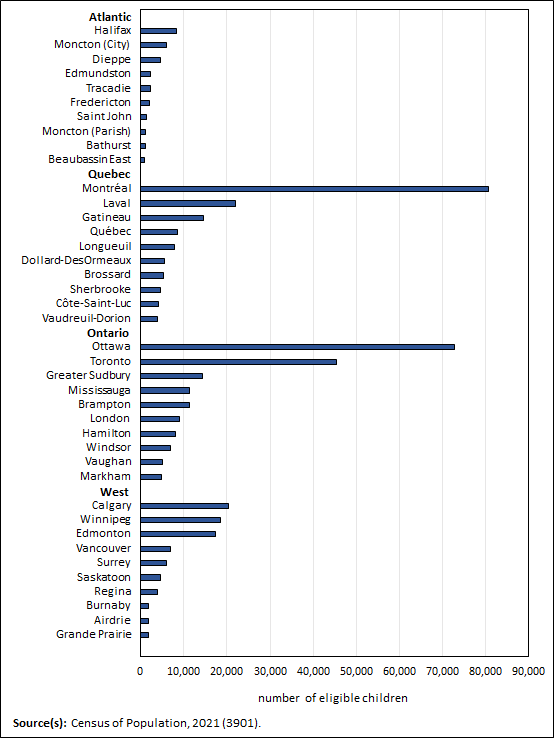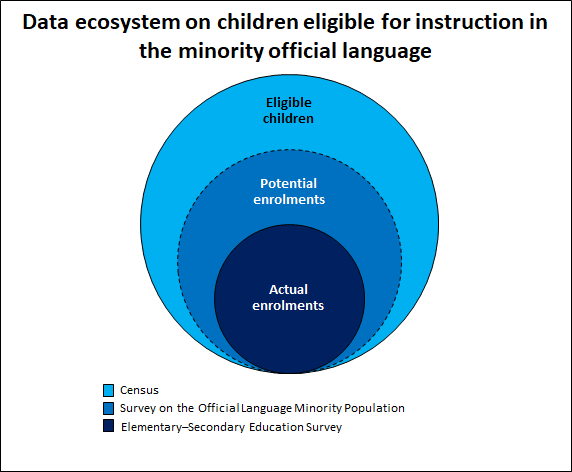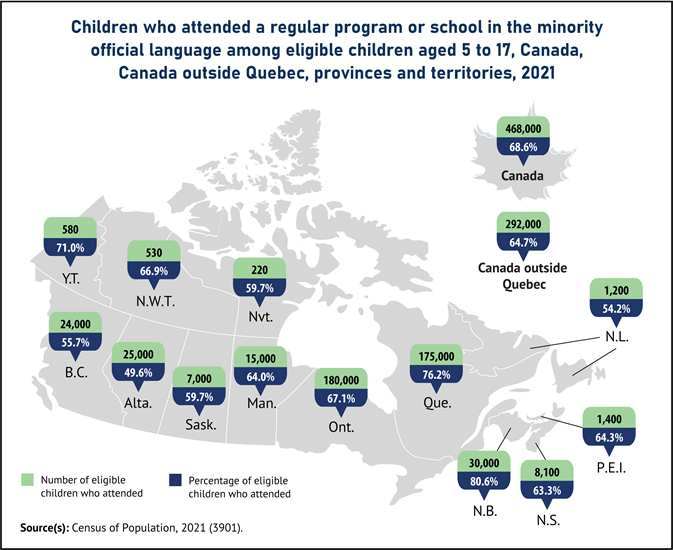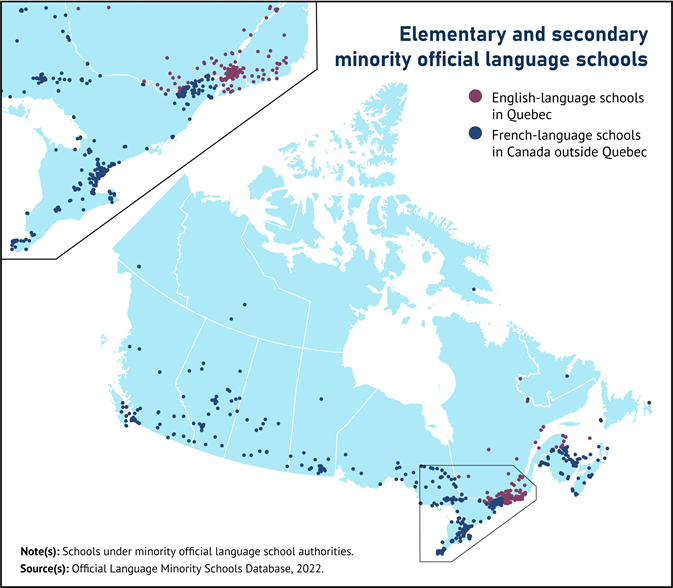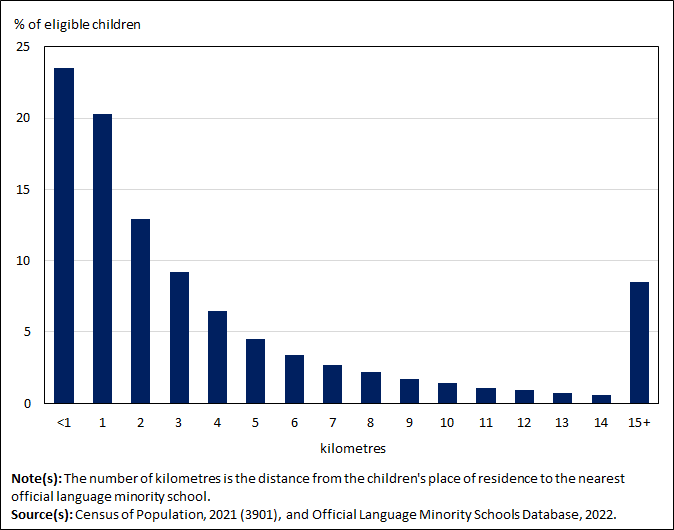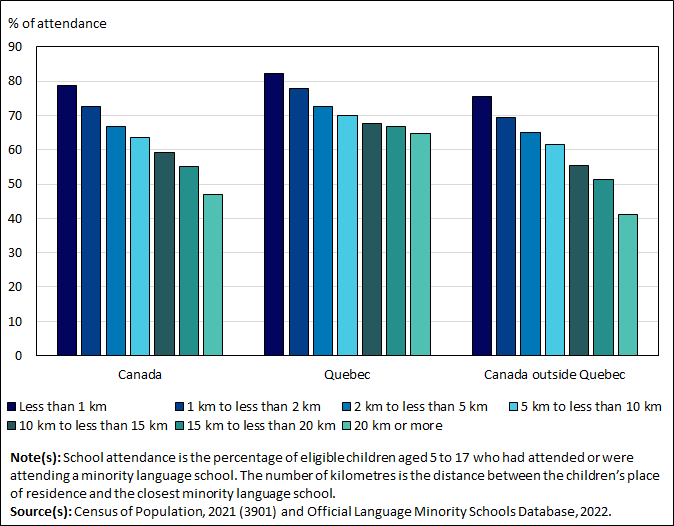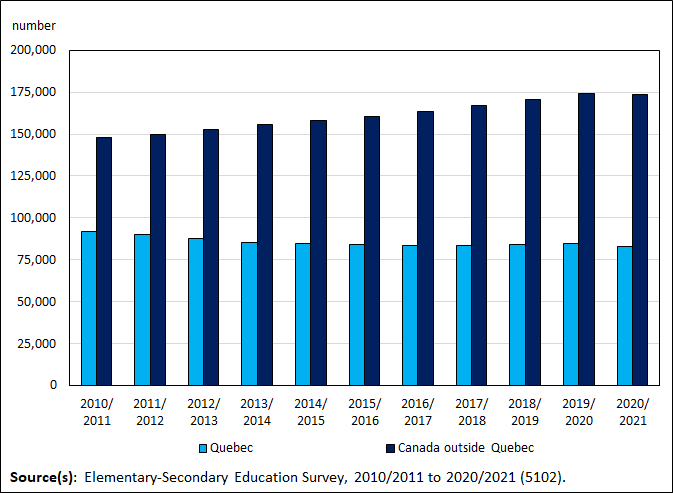897,000 children are eligible for instruction in the minority official language in Canada
Released: 2022-11-30
Learning in the minority language: Counting eligible children with the census
Education in the minority official language plays a key role for English-speaking language communities in Quebec and francophone communities in Canada's other provinces and territories. In childhood, school is a place where children not only learn a language, but also live in that language—beyond their family and immediate environment. For minority linguistic communities, minority language instruction is often considered essential for preserving and developing language and culture.
Following extensive consultations with Canadians, experts, and provincial and community representatives, new questions were added to the 2021 Census to enumerate children eligible for instruction in the minority official language based on criteria established by the Canadian Charter of Rights and Freedoms. The findings from the responses to these new questions are now available for various levels of geography. Although these new data have some limitations, they represent a key pillar of the data ecosystem on the children eligible for instruction in the minority official language that Statistics Canada is currently developing.
In 2021, across Canada, 897,000 children who were under the age of 18 on December 31, 2020, were eligible for primary and secondary school instruction in the minority official language.
Children eligible for instruction in the minority official language may or may not have attended an education program in the minority official language. Some are too young and have not yet started school. Other children who are school-aged never received instruction in the minority official language for a variety of reasons, such as parental decisions or the distance to school.
The data released today provide a portrait of schooling in the minority official language of both children and adults. Among the Quebec population, close to 1 million people aged 5 and older attended an English-language school in Canada during their childhood. In Canada outside Quebec, 1.3 million people aged 5 and older have attended a regular French program in a French-language school in Canada. This number does not include the 1.6 million people living outside Quebec who have attended a French immersion program in an English-language school—and have never attended a French-language school.
These data provide a new avenue for evidenced-based decisions for policy makers, school infrastructure planners, and educational service providers, such as provincial ministries of education and school boards across the country. They will also be very useful for representatives of official language minority communities and people interested in the educational needs of children, especially those of children from these communities.
Highlights
The 2021 Census of Population provides new data on the children eligible for instruction in the minority official language at the primary and secondary levels, based on the three criteria established by the Canadian Charter of Rights and Freedoms.
In 2021, 897,000 children were eligible for instruction in the minority official language at the primary and secondary levels, namely in English in Quebec (304,000) and in French in Canada outside Quebec (593,000).
Among the provinces and territories in Canada outside Quebec, Ontario (350,000), Alberta (67,000), British Columbia (56,000), New Brunswick (49,000) and Manitoba (30,000) had the highest population of children eligible for instruction in French.
Among the provinces and territories, New Brunswick (36.0%), Quebec (18.1%), Yukon (14.1%) and Ontario (12.6%) had the largest proportions of children eligible for instruction in the minority official language. About 1 in 10 children (10.5%) were eligible for instruction in French in Canada outside Quebec.
Across Canada, over 90% of eligible children were living within 15 kilometres of a minority official language school.
In Canada outside Quebec, 292,000 school-aged children attended a regular French program at a primary or secondary French-language school in Canada, representing 64.7% of eligible children aged 5 to 17. This proportion was higher in New Brunswick (80.6%) and Yukon (71.0%), but lower in British Columbia (55.7%), Newfoundland and Labrador (54.2%) and Alberta (49.6%). In Quebec, 175,000 school-aged children attended an English primary or secondary school in Canada, representing 76.2% of eligible children aged 5 to 17 in this province.
The new data on language of instruction show that, among persons in Canada outside Quebec aged 5 years and older, almost 1.2 million studied in a regular French program in a French-language school, 1.6 million in a French immersion program, and 137,000 in both types of programs.
Nearly 1 million people aged 5 and older living in Quebec at the time of the 2021 Census studied at an English primary or secondary school in Canada.
Who has the right to instruction in the minority language?
Since it was adopted in 1982, the Canadian Charter of Rights and Freedoms recognizes the right to instruction in the minority official language at the primary and secondary levels, i.e., in English in Quebec or in French in Canada's other provinces and territories.
Individuals with the right to have their children receive instruction in the minority official language are Canadian citizens who meet at least one of the three criteria set out in section 23 of the Charter:
1) Individuals whose first language learned and still understood, i.e., mother tongue, is the minority official language of their province or territory of residence. In Quebec, the mother tongue criterion does not apply; the other two criteria apply.
2) Individuals who did their primary schooling in Canada, in English for Quebec residents or in French for residents outside Quebec. Instruction may have been received anywhere in Canada regardless of the current province or territory of residence. Instruction in French does not include French immersion programs because those are French as a second language programs provided by English-language schools.
3) Individuals whose child has received or is receiving instruction at the primary or secondary level in Canada, namely in English for Quebec residents, or in French (excluding immersion programs) for residents of the other provinces and territories.
Children with at least one parent who meets at least one of these criteria are eligible for instruction at the primary and secondary level in the minority official language where the numbers warrant.
The Charter states that these criteria apply to Canadian citizens. However, the census has citizenship information only for a portion of the population (25%) who responded to the census long-form questionnaire. Therefore, eligibility that is determined using census data—and examined in this release—does not factor in citizenship. However, the impact of parents' citizenship requirement on the number of children eligible for instruction in the minority official language can be estimated using the census long-form questionnaire. In 2021, across Canada, a small proportion of children eligible for instruction in the minority official language did not have at least one Canadian citizen parent who met at least one of the above criteria. Data tables will be available in 2023 for users to consider parents' citizenship requirement.
For more information, see the Instruction in the Minority Official Language Reference Guide, Census of Population, 2021.
Close to one in eight children in Canada, or 897,000 children, are eligible for instruction in the minority official language
The new census questions on language of instruction help to determine the number of children under the age of 18 for whom the Canadian Charter of Rights and Freedoms guarantees the right to instruction in the minority official language at the primary and secondary levels, i.e., instruction in English in Quebec and French in Canada outside Quebec.
In Canada, of the 7.3 million children who were under 18 years of age on December 31, 2020, 897,000 were eligible for instruction in the minority official language, representing close to one in eight children (12.2%).
Among these children, more than 215,000 were under 5 years of age (preschool-aged), and 682,000 were aged 5 to 17 (school-aged), which generally corresponds to the ages when children attend primary or secondary school.
Nearly two-thirds of children eligible for instruction in the minority official language in Canada were living outside Quebec, where French is the minority official language, while just over one-third were living in Quebec, where English is the minority official language.
In Quebec, 304,000 children were eligible for instruction in English, accounting for more than one in six children (18.1%). Among these children, nearly 74,000 were under 5 years of age, 122,000 were aged 5 to 11 years, and nearly 108,000 were aged 12 to 17.
In Canada outside Quebec, 593,000 children under 18 years of age, or just over 1 in 10 children (10.5%), were eligible for instruction in French. Among them, close to 141,000 were preschool-aged and 452,000 were school-aged. Of eligible school-aged children, 247,000 were aged 5 to 11 years and more than 206,000 were aged 12 to 17 years on December 31, 2020.
Less than half (44.6%) of eligible children living in Canada outside Quebec are eligible because French is the mother tongue of their parents. In Quebec, where the mother tongue eligibility criterion does not apply, nearly two-thirds (65.5%) of children are eligible because their parents did their primary schooling in an English-language school in Canada.
Children eligible for instruction in the minority official language based on the eligibility criteria
The new census questions on language of instruction were combined with other characteristics of the household members, such as family relationships and mother tongue, in order to produce the number of children eligible for instruction in the minority official language.
In Quebec, about two-thirds (65.5%) of children eligible for instruction in an English-language school are eligible because they have at least one parent who did primary schooling in an English-language school in Canada. The remaining one-third or so of eligible children (34.5%) are eligible only because they themselves, a brother or a sister did primary or secondary schooling in an English-language school in Canada.
In Canada outside Quebec, where the parents' mother tongue is an eligibility criterion, less than half (44.6%) of children eligible for instruction in a French-language school have at least one parent whose mother tongue is French. Nearly one-quarter of eligible children (23.9%) are instead eligible because at least one of their parents did primary schooling in a French-language school in Canada, and close to one-third (31.5%) are eligible only because they themselves, a brother or sister did primary or secondary schooling in a French-language school in Canada.
As shown in Infographic 2, many children in and outside Quebec are eligible under more than one criterion.
More than one in three children are eligible for instruction in French in New Brunswick
The number and proportion of children under the age of 18 who are eligible for instruction in the minority official language are strongly associated with the geographic distribution and demographic weight of the francophone population in Canada outside Quebec or the English-speaking population in Quebec.
Among the provinces outside Quebec, Ontario (350,000), Alberta (67,000), British Columbia (56,000), New Brunswick (49,000) and Manitoba (30,000) had the highest number of children eligible for instruction in French in 2021.
Conversely, Nunavut (530), the Northwest Territories (1,100) and Yukon (1,200) had the smallest number of children eligible for instruction in French.
If we consider the proportion of eligible children in each province and territory, rather than the number, New Brunswick (36.0%), Quebec (18.1%), Yukon (14.1%) and Ontario (12.6%) had the highest percentages in the country.
The Western provinces had some of the lowest proportions of eligible children in Canada, with 6.9% in Alberta, 6.3% in British Columbia and 5.8% in Saskatchewan. Nunavut (3.7%) and Newfoundland and Labrador (3.5%) came in at the bottom of the list.
Nearly half of all children eligible for instruction in the minority official language live in the large urban centres of Montréal, Toronto and Ottawa–Gatineau
Like the Canadian population and the minority official language population, the vast majority of children eligible for instruction in the minority official language were living in large urban centres in 2021.
Moreover, nearly three-quarters (73.9%) of schools offering education programs in the minority official language were also located in urban centres.
Nearly half of the 897,000 children under 18 years who were eligible for instruction in the minority official language were living in the large urban centres of Montréal (199,000), Toronto (104,000) and Ottawa–Gatineau (101,000).
They were followed by the large urban centres of Vancouver (28,000), Edmonton (25,000), Calgary (24,000) and Winnipeg (22,000), all located in Western Canada and where many francophones—notably from Quebec—have been migrating for decades.
Many urban centres in New Brunswick and Ontario located near their respective borders with Quebec had the highest proportions of children eligible for instruction in French in 2021. They included the urban centres of Edmundston (97.5%), Bathurst (78.2%) and Campbellton (73.3%) in northern New Brunswick, Hawkesbury (83.4%) in eastern Ontario, and Timmins (59.1%) in northern Ontario. Moncton (46.1%), Greater Sudbury (46.0%), Cornwall (40.5%) and the large urban centre of Ottawa (35.7%) also had a high proportion of eligible children.
In Quebec, the large urban centres of Gatineau (24.5%) and Montréal (22.9%) and the urban centres of Cowansville (25.0%) in the Estrie region, and Lachute (20.6%) in the Laurentides had the highest proportions of children eligible for instruction in English-language schools.
Many of these urban centres have a high proportion of English- and French-speaking residents. In these areas, the English–French bilingualism rate is also high, as shown by the 2021 Census data on language released on August 17, 2022.
In Canada, 135 municipalities have more than 1,000 children eligible for instruction in the minority official language
One of the main strengths of the census is that it helps to produce population counts at the local level, such as municipalities. Often, the counts at this level are considered when determining the need for educational services and for schools, including in the minority official language.
For example, the census helped to determine that, in 2021, 135 municipalities had more than 1,000 children eligible for instruction in the minority official language.
The vast majority of these municipalities were in the country's large urban centres. For example, 31 of them were in the large urban centre of Montréal (Montréal, Laval and Longueuil had the highest numbers), 14 were in the large urban centre of Toronto (the highest numbers were in Toronto, Mississauga, Brampton) and 5 were in the large urban centre of Ottawa–Gatineau (Ottawa, Gatineau, Clarence-Rockland had the highest numbers).
In Atlantic Canada, the largest numbers of eligible children were in the large urban center of Moncton (14,000) in southeastern New Brunswick and in the northern part of the province, including the Acadian Peninsula. Overall, approximately 29,000 eligible children were living in the province's urban centres, while more than 20,000 eligible children were distributed across many small rural or coastal francophone communities such as Tracadie (2,200), Shediac (1,400) and Shippagan (1,000).
About half of eligible children in the rest of Atlantic Canada were living in the capital of their respective province, i.e., Halifax, in Nova Scotia, St. John's, in Newfoundland and Labrador, and Charlottetown, in Prince Edward Island.
In Ontario, in addition to the municipalities within large urban centres such as Toronto, Ottawa, Windsor and Greater Sudbury, many children eligible for instruction in French were living in various municipalities in northeastern and southeastern Ontario. In the northeast, Timmins had close to 5,000, North Bay had 2,900, and West Nipissing had 2,000, for example. In the southeast, 3,600 were living in Cornwall, 1,600 in Alfred and Plantagenet, and 1,400 in South Glengarry.
In Western Canada, almost all municipalities with more than 1,000 eligible children were in large urban centres, mainly Vancouver in British Columbia, Edmonton and Calgary in Alberta, and Winnipeg in Manitoba.
This was also the case in Quebec, where 31 of the 43 municipalities with more than 1,000 eligible children were in the Greater Montréal area.
Looking ahead: A "data ecosystem" to estimate potential enrollments in minority official language schools
The Census of Population now provides the number and proportion of children eligible for instruction in the minority official language for communities across Canada as well as information about individuals who have been instructed in the minority official language of their province of residence.
The Survey on the Official Language Minority Population, the results of which will be available in 2024, will help to evaluate the reasons for participation or non-participation in minority official language programs as well as parents' intentions for enrolling their children in the future.
The Elementary–Secondary Education Survey provides the annual enrollments of students registered in public education programs in the minority official language.
The Official Language Minority Schools Database provides information on the location of these schools and makes it possible to calculate the distance to the closest minority official language school.
Over time, more studies will enrich this data ecosystem on children eligible for instruction in the minority official language.
More than two-thirds of children eligible for instruction in the minority official language received instruction in that language
School-aged children eligible for instruction in the minority official language may, or may not, have received instruction in that language.
In Canada, nearly one-third (31.4%) of eligible children aged 5 to 17 years had never attended a minority official language program.
In contrast, 468,000 children had attended or were, at the time of the census, attending a minority official language school, representing more than two-thirds (68.6%) of children eligible for instruction in the minority official language.
These children may have had different educational paths. For example, some received only part of their instruction in the minority official language, while others attended programs in the minority official language of their province from kindergarten to the end of secondary school.
In Quebec in 2021, 175,000 children aged 5 to 17 had attended an English-language school in the past or were attending one at the time of the census. This represents just over three-quarters (76.2%) of eligible children in this age group.
In Canada outside Quebec, 292,000 eligible children (64.7%) had attended or were attending a regular French program in a French-language school at the time of the census.
The lower attendance in French-language schools outside Quebec (-11.5 percentage points) is due in part to French immersion programs being offered in English-language schools throughout the country. In fact, one in eight (12.5%) school-aged children eligible to attend a French-language school outside Quebec had instead attended a French immersion program in an English-language school.
Overall, nearly one-quarter (23.8%) of school-aged children living in Quebec who were eligible for instruction in English had never attended an English-language school. Outside Quebec, a similar proportion (22.8%) of children eligible for instruction in French had never done primary or secondary schooling in French, either in a French-language school or in a French immersion program.
Among the provinces and territories, New Brunswick (80.6%), Quebec (76.2%) and Yukon (71.0%) had the highest proportions of school-aged eligible children who had attended a regular French program or a minority official language school. Conversely, Alberta (49.6%), Newfoundland and Labrador (54.2%) and British Columbia (55.7%) had the lowest proportions.
There are a number of reasons why some eligible children have never attended a minority official language school, including, for instance, parents' preferences or the distance to the closest school. In 2024, the Survey on the Official Language Minority Population will provide information on the reasons for choosing a school for children eligible for instruction in the minority official language.
Aside from the distance to the closest school, the provincial and territorial variation in attendance in minority official language schools is associated with, among other things, the transmission of the minority official language as a mother tongue. Parents who transmitted the minority official language as the mother tongue of their children are more likely to enroll them in a minority official language school. In Canada outside Quebec, 87.6% of eligible school-aged children with French as their mother tongue had already attended a French-language school or were doing so in 2021, compared with 55.7% of those whose mother tongue is not French.
More than 90% of eligible children live within less than 15 kilometres of a minority official language school, both in Quebec and Canada outside Quebec
The 2021 Census data on children eligible for instruction in the minority official language were combined with data on the location of minority official language schools to determine the distance between eligible children's place of residence and the geographic location of those educational institutions.
At the national level, 91.5% of eligible children under 18 years of age were living within less than 15 kilometres of a minority official language school in 2021. This percentage was relatively similar in Quebec (93.5%) and in Canada outside Quebec (90.5%).
If we lower the distance to living within less than 10 kilometres, this proportion drops to 86.8%, and was relatively similar in Quebec (89.3%) and in Canada outside Quebec (85.6%).
Not surprisingly, the average distance between the place of residence and the closest minority official language school was greater in rural areas (19.7 km)—four times greater, in fact—than in urban areas (4.9 km).
In the country's urban areas, 95.7% of eligible children were living within less than 15 km of a minority official language school in 2021, compared with 70.6% in rural areas. In urban areas, 93.0% of eligible children were living within less than 10 km of a minority official language school, compared with over half (56.2%) in rural areas.
The analysis of data on the location of minority official language schools in combination with the 2021 Census data also shows that the further away eligible school-aged children live from a minority official language school, the less likely they are to have ever attended a school of the same language. This was observed in both urban and rural areas.
In Quebec, for example, 82.3% of eligible children aged 5 to 17 who live within less than 1 km of an English-language school had previously attended or were attending an English-language school at the time of the census. That proportion fell to 66.1% among children living 10 km or more from an English-language school.
In Canada outside Quebec, more than three-quarters (75.5%) of eligible children living within less than 1 km of a French-language school had previously attended or were attending a French-language school at the time of the census—compared with less than half (47.6%) of eligible children living 10 km or more from a minority school.
As Infographic 6 shows, attendance at regular French programs in French-language schools declines more sharply in Canada outside Quebec as the distance between the eligible child's place of residence and the nearest French-language school increases. Other analyses will shed further light on this correlation, including the findings from the Survey on the Official Language Minority Population.
In British Columbia, Alberta and Ontario, about half of the school-aged children who had attended a French-language school had an immigrant background
In 2021, the proportion of immigrants within the English-speaking population in Quebec was 35.8%, while the proportion of immigrants in the French-speaking population outside Quebec was 17.4%, according to first official language spoken.
Over the generations, diversity within these populations has been even more pronounced among children. In 2021, more than one-third (38.5%) of children eligible for instruction in the minority official language had an immigrant background, meaning that they were born outside Canada or that one or both of their parents were born outside Canada. This proportion was similar in Quebec (37.7%) and in Canada outside Quebec (38.9%), based on the census long-form sent to 25% of Canadian households.
In Canada outside Quebec, the proportion of eligible children with an immigrant background was higher in British Columbia (45.3%), Ontario (44.0%) and Alberta (41.1%), while it was roughly half the rate in the Atlantic provinces, where children with an immigrant background accounted for less than 20% of eligible children. Every year, many immigrants settle in British Columbia, Ontario and Alberta, and fewer choose the Atlantic provinces.
In 2021, just over 4 in 10 school-aged children (42.7%) who had attended a minority official language school had an immigrant background. This proportion was similar in Quebec (41.7%) and in Canada outside Quebec (43.3%). However, it was higher in British Columbia (55.5%), Alberta (49.1%) and Ontario (48.7%), but lower in New Brunswick (12.3%), Prince Edward Island (18.0%) and in Nova Scotia (19.8%).
Enrollments in public programs in the minority official language were up in the decade preceding the COVID-19 pandemic
According to the Elementary–Secondary Education Survey, the number of annual enrollments in public education programs in the minority official language in Canada rose over the course of a decade, from close to 240,000 students in 2010/2011 to nearly 260,000 in 2019/2020. This represents an 8.2% increase in 10 years. This upward trend excludes the decrease to under 257,000 students observed in 2020/2021, the first full school year affected by the COVID-19 pandemic.
As shown in Infographic 7, this increase is attributable to the sustained growth seen in Canada outside Quebec, where the number of annual enrollments in regular French programs rose by 18.1%, from less than 150,000 in 2010/2011 to close to 175,000 in 2019/2020.
In contrast, in Quebec, annual enrollments in English public education programs fell from 92,000 in 2010/2011 to 85,000 in 2019/2020, a decrease of 7.8%. However, there was a slowdown in that decrease from 2014/2015 to 2017/2018, which was followed by a slight increase in enrollments since 2018/2019, with the exception of 2020/2021, the last year for which data are available.
The sustained growth in enrollments in regular French programs observed in Canada outside Quebec in the 2010s was driven by the combined effects of supply and demand, including immigration and the construction of new schools over the years.
Nearly 1 million Quebec residents were schooled in an English-language school, and almost 3 million people living outside Quebec were schooled in a French immersion program or a French-language school
The new data on languages of instruction provide a portrait of schooling in the minority official languages in Canada not only among children, but among adults as well.
In Quebec, when looking at the entire population aged 5 and older, nearly 1 million people had attended an English-language primary or secondary school in Canada for at least a year in their childhood. This represents close to one in eight people (12.3%) aged 5 years and older who were living in Quebec in 2021.
This proportion was higher among young adults aged 18 to 24 (16.7%) than in the other age groups. Just over half of Quebec residents who were educated in an English-language school anywhere in Canada had English as their mother tongue.
Intensive English programs offered by some schools in Quebec are not included in this portrait because they are second-language education programs offered by French schools. In addition, the census does not collect data from Quebec residents on whether they attended French immersion programs offered by English schools. These programs, which were created in Quebec in the 1960s, are still offered there, as they are also now across Canada in English-language schools.
In 2021, in Canada outside Quebec, 1.3 million people were being or had been schooled in childhood in a regular French program in a French-language school in Canada, representing 5.0% of the population aged 5 and older. This includes 137,000 people who also attended a French-immersion program during their education. Among all age groups, this proportion was the highest among children aged 5 to 17 (7.0%). Among those who attended a French-language school, the majority had French as their mother tongue.
In 2021, in addition to the 1.3 million people who had attended a French school, there were also 1.6 million people in Canada outside Quebec who attended a French immersion program but had never attended a French school. The large majority (87.7%) of individuals who attended a French immersion program had English as their mother tongue, in contrast to what is observed among those who attended a French-language school.
In 2021, among children aged 5 to 17 living in Canada outside Quebec, 16.0% had attended a French immersion program, compared with 10.6% of young adults aged 18 to 24, and 4.9% of people aged 25 to 60. These variations among age groups reflect the periods associated with the creation, development, and increased access to and popularity of French immersion programs in Canada. French immersion programs were not yet offered when people now over the age of 60 were in school. It is worth noting that French immersion programs are programs offered by English-language schools.
If we add up the number of people aged 5 and older who attended a French-language school or attended an immersion program, in 2021, almost 3.0 million people in Canada outside Quebec had pursued primary or secondary schooling in French in Canada.
Looking ahead
The information published today will enhance the dataset available on children eligible for instruction in the minority official language. This release provides a first glimpse into the analytical potential of these new data. Supplementary data products will be made available in coming months, starting on December 15, 2022. Among them, the Census Profile will include the number of children eligible for instruction in the minority official language at the local level. New data tables will allow users to obtain results on language of instruction according to various characteristics and regions.
Other data products and studies are also planned to increase data availability and deepen the knowledge on this topic using, among others, data from the Survey on the Official Language Minority Population.
For more information on the new questions on the language of instruction, on children eligible for instruction in the minority official language, on the definitions or on data quality, refer to the Instruction in the Minority Official Language Reference Guide, Census of Population, 2021 and the Minority language educational rights: Technical report on changes for the 2021 Census.
Note to readers
Limitations of the census data on children eligible for instruction in the minority official language
The results presented in this release reflect the most accurate and up-to-date number of children eligible for instruction in the minority official language, in accordance with the criteria set out in section 23 of the Canadian Charter of Rights and Freedoms. However, as with any estimate, those presented today based on the Census of Population have some limitations.
The first arises from legal specificities that the census cannot explicitly take into account. For example, the questions on mother tongue and language of instruction are on the census short-form questionnaire distributed to the whole population, while the question on Canadian citizenship—the requirement in section 23 of the Charter—is on the long-form questionnaire distributed to one in four households. As a result, the data combining citizenship and language of instruction are obtained based on a sample representing 25% of Canadian private households. The same is true for the data on the generation status of children with an immigrant background.
A second limitation comes from the fact that some children are only eligible because of a family member who was not living with them at the time of the census. The census cannot establish these family relationships as it only gathers information on family relationships between people living in the same dwelling on Census Day.
In this context, the census results must be interpreted as a statistical operationalization of the concept of children eligible for instruction in the minority official language, rather than as a definition that is faithful in every respect to its precise legal framework. Finally, the issue of eligibility is ultimately a legal matter that requires a case-by-case analysis.
As such, Statistics Canada considers the census to be a pillar in a broader data ecosystem on children eligible for instruction in the minority official language, which over the years will be enhanced with additional information.
Definitions, concepts and geography
In this release, children are defined as having under 18 years of age on December 31, 2020, and refer to children born on or after January 1, 2003. This also includes children born between January 1, 2021, and Census Day. Preschool-aged children were under 5 years of age on December 31, 2020, i.e., they were born on or after January 1, 2016. School-aged children were aged 5 to 17 on December 31, 2020, i.e., they were born between January 1, 2003, and December 31, 2015, inclusively. The number of children by age group on December 31, 2020, may differ from the number of children in forthcoming data tables that will include age groups based on age on Census Day. In this release, attendance is defined as the percentage of eligible children aged 5 to 17 who were attending or had previously attended for at least one year in Canada a school in the minority official language of their province or territory of habitual residence.
The figures are calculated using rounded data and may not necessarily correspond to the totals.
All the results presented in this release are based on the 2021 geographic boundaries. In this release, the term large urban centre refers to a census metropolitan area (CMA). A CMA is an urban centre with a population of 100,000 or more. The large urban centre of Ottawa corresponds to the Ontario part of the Ottawa–Gatineau CMA, and the large urban centre of Gatineau corresponds to the Quebec part of the Ottawa–Gatineau CMA. The term urban centre refers to a census agglomeration, while the term municipality, in this release, refers to a census subdivision.
The distance between the place of residence of eligible children and the closest minority official language school corresponds to the "as the crow flies" distance between the centre of the city block where the eligible child lives and the exact coordinates of the closest minority official language school in his province or territory of residence. Since the Minority Official Language Schools Database includes only schools under the jurisdiction of Minority Official Language School Authorities, only the areas under the jurisdiction of these authorities are included in the distance analysis, with very few exceptions.
For a detailed definition of the concepts of instruction in the minority official language or of census geographies, consult the Census Dictionary.
2021 Census of Population products and releases
Today, Statistics Canada is releasing a seventh set of results from the 2021 Census of Population.
Several 2021 Census products are now available on the 2021 Census Program web module. This web module has been designed to provide easy access to census data, free of charge.
The analytical products include an article in The Daily.
Additional data products and Census in Brief articles will be released in the coming months.
Data products including results on instruction in the minority official language, for many standardized geographic regions, will be available December 15, 2022, through the Census Profile, Highlight tables and data tables.
The reference materials are designed to help users make the most of census data. They include the Guide to the Census of Population, 2021, the Dictionary, Census of Population, 2021, the 2021 Census of Population questionnaires and the 2021 Census Data Quality Guidelines. The dictionary, reference guides and data quality guidelines are updated based on new information throughout the release cycle. The Instruction in the Minority Official Language Reference Guide, Census of Population, 2021 and the Languages Reference Guide, Census of Population, 2021 are also available.
Geographic products and services related to the 2021 Census Program can be found under Census geography. This includes GeoSearch, an interactive mapping tool, and thematic maps, which show data for various standard geographic areas, along with the Focus on Geography series and the Census Program Data Viewer, which are data visualization tools.
Videos on census concepts can be viewed in the Census learning centre.
November 30, 2022, marks the final major release from the 2021 Census of Population. Please see the 2021 Census release schedule for a full list of the topics that have already been released.
Contact information
For more information, or to enquire about the concepts, methods or data quality of this release, contact us (toll-free 1-800-263-1136; 514-283-8300; infostats@statcan.gc.ca) or Media Relations (statcan.mediahotline-ligneinfomedias.statcan@statcan.gc.ca).
- Date modified:

